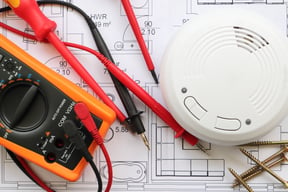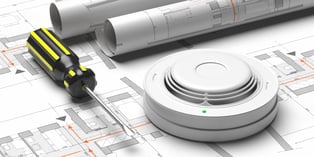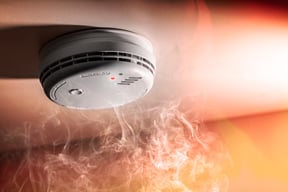 Fire safety history has come a long way in the last several centuries. From starting with simple, manual fire sprinkler systems to today’s modern technology, each advance has led us closer to ideal fire and life safety protection.
Fire safety history has come a long way in the last several centuries. From starting with simple, manual fire sprinkler systems to today’s modern technology, each advance has led us closer to ideal fire and life safety protection.
And, in the world of fire and life safety, few devices save more lives than smoke detectors.
How were smoke detectors invented, and how have they evolved over time? We’re taking a deep dive in this blog into the first types of detectors, as well as how they work today.
The First Smoke Detector
The first smoke detector was invented in 1902 by George Andrew Darby, an electrical engineer. The first detector device was a heat detector, not a smoke detector. It indicated a temperature increase where it was fixed. The device worked by closing an electrical circuit to sound an alarm when the temperature exceeded a safe limit. The two plates were connected by a block of butter melting as the temperature rose.
Invention of the Ionization Detector
Smoke detectors have undergone a remarkable evolution over time, departing from the unconventional use of blocks of butter. In the 1920s, Swiss physicist Walter Jaeger inadvertently created the first smoke detector sensor while working on a poison gas sensor. Later, in 1939, Dr. Ernst Meli, another Swiss physicist, developed an ionization chamber device capable of detecting gasses, ushering in the first ionization smoke alarm era. This innovative technology enabled the detection of invisible smoke particles, transforming the landscape of fire safety.
The Invention of the Photoelectric Detector
In the early 1960s, Duance Pearsall, the "father of smoke detectors," and Stanley Bennett Peterson developed the first home smoke detector featuring a replaceable battery. Subsequently, in 1972, Donald Steele and Robert Emmack patented the photoelectric smoke detector, also called the "optical detector." These detectors incorporate a light sensor that triggers an alarm upon detecting an elevated light input and smoke entering the optical chamber. Photoelectric detectors effectively detect slow-burning, smoky fires; however, they may not be as reliable in detecting fires originating from cooking or steam.
The Evolution of Modern Fire Detectors
In the 1970s, smoke detectors experienced rapid sales, revolutionizing home safety and saving lives. Today, smoke detectors serve as sensors, while fire alarms generate audible alerts. Most detectors double as fire alarms and operate either electrically or on batteries. Building codes typically mandate smoke detectors connected to the building's main electrical supply in modern construction. Many units also feature battery backups to maintain functionality during power outages.
Modern fire detectors are either ionization alarms, photoelectric alarms, or frequently a combination of both. Ionization alarms are better at detecting fires that produce flames, whereas photoelectric alarms excel at detecting smoldering or low-flame fires.
It's important to note that unless equipped with an integrated carbon monoxide detector, a standard smoke detector cannot detect carbon monoxide, which can lead to poisoning.
For tips on smoke detector and fire alarm use and safety, follow us on Facebook, Instagram and LinkedIn as we share fire safety tips, or learn more on the NFPA’s website.




